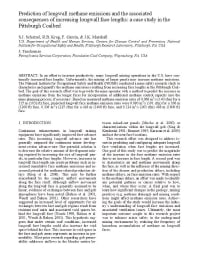Mining Publication: Prediction of Longwall Methane Emissions and the Associated Consequences of Increasing Longwall Face Lengths: A Case Study in the Pittsburgh Coalbed
Original creation date: June 2006
Authors: SJ Schatzel, RB Krog, F Garcia, JK Marshall, J Trackemas
NIOSHTIC2 Number: 20030320
Proceedings of the 11th U.S./North American Mine Ventilation Symposium, University Park, Pennsylvania, June 5-7, 2006. Mutmansky JM, Ramani RV. eds., London, U.K.: Taylor & Francis Group, 2006 Jun; :375-382
In an effort to increase productivity, many longwall mining operations in the United States have continually increased face lengths. Unfortunately, the mining of larger panels may increase methane emissions. NIOSH conducted a mine safety research study to characterize and quantify the methane emissions resulting from increasing face lengths in the Pittsburgh Coalbed. The goal of this research effort was to provide the mine operator with a method to predict the increase in methane emissions from the longer faces for incorporation of additional methane control capacity into the mine planning process, if necessary. Based on measured methane emission rates of 140 cfm for a 1,032-ft face, projected longwall face methane emission rates were 191 cfm for a 1,200-ft face, 225 cfm for a 1,400-ft face, and 263 cfm for a 1,600-ft face.

NIOSHTIC2 Number: 20030320
Proceedings of the 11th U.S./North American Mine Ventilation Symposium, University Park, Pennsylvania, June 5-7, 2006. Mutmansky JM, Ramani RV. eds., London, U.K.: Taylor & Francis Group, 2006 Jun; :375-382
- A CART Technique to Adjust Production from Longwall Coal Operations under Ventilation Constraints
- Development and Application of Reservoir Models and Artificial Neural Networks for Optimizing Ventilation Air Requirements in Development Mining of Coal Seams
- Guidelines for the Control and Monitoring of Methane Gas on Continuous Mining Operations
- Guidelines for the Prediction and Control of Methane Emissions on Longwalls
- Modeling and Prediction of Ventilation Methane Emissions of U.S. Longwall Mines Using Supervised Artificial Neural Networks
- Predicting Methane Emissions from Longer Longwall Faces by Analysis of Emission Contributors
- Remote Methane Sensors
- Reservoir Modeling-Based Prediction and Optimization of Ventilation Requirements During Development Mining in Underground Coal Mines
- Reservoir Rock Properties of Coal Measure Strata of the Lower Monongahela Group, Greene County (Southwestern Pennsylvania), from Methane Control and Production Perspectives
- Technology News 465 - Method for Predicting Methane Emissions on Extended Longwall Faces